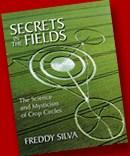 Secrets
in the Fields: The Science and Mysticism of Crop Circles
Secrets
in the Fields: The Science and Mysticism of Crop Circles  Secrets
in the Fields: The Science and Mysticism of Crop Circles
by Freddy
Silva
332 pages -
Illustrated (color/B&W)
2002 /
Hampton Roads Publishing Co., Inc. - $19.95 / 8.00 (new/used)
Secrets
in the Fields: The Science and Mysticism of Crop Circles
by Freddy
Silva
332 pages -
Illustrated (color/B&W)
2002 /
Hampton Roads Publishing Co., Inc. - $19.95 / 8.00 (new/used)
As a bibliophile who does not subscribe to snobbery in choices of reading material, I have delved into many and varied genres, a literary gamut from architecture to Zen yoga, so seldom do I find myself daunted by the content of a written work, unless perhaps it is in a mathematical textbook. The incomprehensibility of a required geometry course in school resulted in educational trauma and cast higher math and I forever into the roles of sworn foes. Whenever possible, interaction is kept to a minimum. Direct confrontations have never been pretty, thus due contemplation was in order upon a decision to purchase Secrets in the Fields. Despite the certainty an engagement with the enemy would lead to an inevitable head-banging-against-brick-wall despair, the mesmeric appeal of the crop formations and a sincere curiosity to know more about the phenomena tipped the scales.
My befuddlement should not be interpreted as an unfavorable recommendation which might deter others from exploring this work, nor taken as an inference the material necessitates a degree in rocket science to grasp. It is merely an advisory for any who feel contracting the plague is preferable to being asked to distinguish between a trapezoid and a rhomboid. Should that be the case, much of the discussion regarding fractals, Mandelbrot sets and diatonic ratios will likely spur a search for supplemental resources which offer less technical explanations of these advanced concepts. Multiple readings will definitely enhance the fullest appreciation of material presented in this volume.
Fortunately Mr. Silva does not plunge his readers into the deep end of the pool immediately. As a lecturer he is aware his audience must first become accustomed to the water before being coaxed onward, and the transition is facilitated by dividing the text into halves. Intentional or not, this stratagem underscores the duality of theme as the title indicates. The author's examination of the subject is dominated by a juxtaposition of concepts without easy reconcile: science/mysticism; anachronistic anomalies/empirical evidence; sacred geometry/physical law, but an effective reconciliation is exactly the goal arrived at. Silva demonstrates through comprehensive research and analysis the divergent disciplines are really interlinked in a staggering number of ways.
Photographs and detailed ink renderings of the formations visually aid assimilation of the data put forth, while anecdotal and eyewitness accounts provide context for a history of the phenomena, its characteristics, theoretical origins, and symbolic codings. Rather than finding a hopeless mire of impenetrable arithmetic, I discovered many ideas with which I have familiarity, making the decision to buy not one I regretted. Whether mundane, cosmological, or esoteric, an incredible scope of knowledge is interpreted in a progressively riveting manner, and thus it was easy to be lured from the shallows into the ocean. Almost before I was aware of it, I was immersed in waves of higher math and not drowning. Admittedly my comprehension of some aspects remains more comparable to a dog-paddle than Olympian strokes but I am staying afloat. So at the risk of capitulating to an old enemy, I invite you to "Come on in...the water's fine, but be careful of the spots over my head!
5***** of 5*****/LadyJEM - 1-25-11